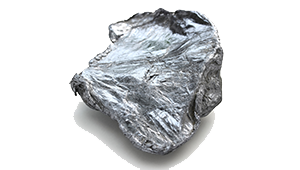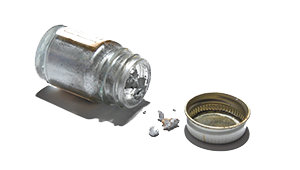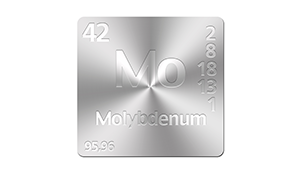
 We strive to provide an environment in which we all are encouraged to share information, work as a team, and inspire those around us to strive for excellence—our educational outreach programs are designed to do just that.
We strive to provide an environment in which we all are encouraged to share information, work as a team, and inspire those around us to strive for excellence—our educational outreach programs are designed to do just that.
All About Moly
Molybdenum is used, principally, as an alloying agent in steel, cast iron, and super alloys to enhance hardening ability, strength, toughness, wear, and corrosion resistance. Molybdenum plays a significant role in contemporary industrial technology which increasingly requires materials that are serviceable under high stress, expanded temperature ranges, and highly corrosive environments. Moreover, molybdenum finds significant usage as a refractory metal in numerous chemical applications including catalysts, lubricants, and pigments. Molybdenum is rapidly becoming a critical metal in the development of green technology and alternative energy.
Uses include:
 steel for wind turbine blades
steel for wind turbine blades- stronger pipelines for oil and gas
- stronger shipping containers
- critical components for water desalination plants
- catalysts to clean diesel
- catalysts to produce clean hydrogen energy
- natural fertilizer
- stronger steel for nuclear reactor walls
3 / 4
Molybdenum
Alloys & Superalloys
Molybdenum does not occur naturally as a free metal on Earth, but rather in various oxidation states in minerals. The free element, which is a silvery metal with a gray cast, has the sixth-highest melting point of any element. It readily forms hard, stable carbides in alloys, and for this reason most of world production of the element (about 80%) is in making many types of steel alloys, including high strength alloys and superalloys.
Compounds
Most molybdenum compounds have low solubility in water, but the molybdate ion MoO42− is soluble and forms when molybdenum-containing minerals are in contact with oxygen and water. Industrially, molybdenum compounds (about 14% of world production of the element) are used in high-pressure and high-temperature applications, as pigments and catalysts.
Enzymes
At least 50 molybdenum-containing enzymes are known in bacteria and animals, although only bacterial and cyanobacterial enzymes are involved in nitrogen fixation, and these nitrogenases contain molybdenum in a different form from the rest. Molybdenum is a required element for life in all higher organisms (eukaryotes), though not in all bacteria.
Elemental Symbol Mo
Molybdenum is a Group 6 chemical element with the symbol Mo and atomic number 42. Molybdenum minerals have been known into prehistory, but the element was discovered (in the sense of differentiating it as a new entity from the mineral salts of other metals) in 1778 by Carl Wilhelm Scheele.
Alloys & Superalloys
Molybdenum does not occur naturally as a free metal on Earth, but rather in various oxidation states in minerals. The free element, which is a silvery metal with a gray cast, has the sixth-highest melting point of any element. It readily forms hard, stable carbides in alloys, and for this reason most of world production of the element (about 80%) is in making many types of steel alloys, including high strength alloys and superalloys.
Compounds
Most molybdenum compounds have low solubility in water, but the molybdate ion MoO42− is soluble and forms when molybdenum-containing minerals are in contact with oxygen and water. Industrially, molybdenum compounds (about 14% of world production of the element) are used in high-pressure and high-temperature applications, as pigments and catalysts.
Enzymes
At least 50 molybdenum-containing enzymes are known in bacteria and animals, although only bacterial and cyanobacterial enzymes are involved in nitrogen fixation, and these nitrogenases contain molybdenum in a different form from the rest. Molybdenum is a required element for life in all higher organisms (eukaryotes), though not in all bacteria.
Elemental Symbol Mo
Molybdenum is a Group 6 chemical element with the symbol Mo and atomic number 42. Molybdenum minerals have been known into prehistory, but the element was discovered (in the sense of differentiating it as a new entity from the mineral salts of other metals) in 1778 by Carl Wilhelm Scheele.
Alloys & Superalloys
Molybdenum does not occur naturally as a free metal on Earth, but rather in various oxidation states in minerals. The free element, which is a silvery metal with a gray cast, has the sixth-highest melting point of any element. It readily forms hard, stable carbides in alloys, and for this reason most of world production of the element (about 80%) is in making many types of steel alloys, including high strength alloys and superalloys.
Compounds
Most molybdenum compounds have low solubility in water, but the molybdate ion MoO42− is soluble and forms when molybdenum-containing minerals are in contact with oxygen and water. Industrially, molybdenum compounds (about 14% of world production of the element) are used in high-pressure and high-temperature applications, as pigments and catalysts.

 We strive to provide an environment in which we all are encouraged to share information, work as a team, and inspire those around us to strive for excellence—our educational outreach programs are designed to do just that.
We strive to provide an environment in which we all are encouraged to share information, work as a team, and inspire those around us to strive for excellence—our educational outreach programs are designed to do just that. steel for wind turbine blades
steel for wind turbine blades




